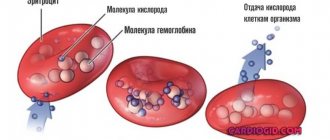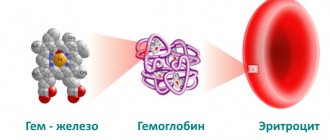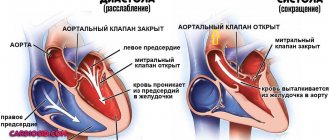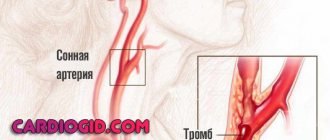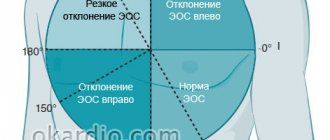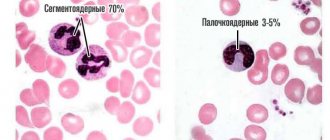Antistreptolysin-O (abbreviated ASLO or ASL-O) is a specific antibody aimed at combating the bacterial agent streptococcus.
As a result of a foreign microorganism entering the patient’s body, the active production of many dangerous enzymes begins.
They provoke intoxication and cause disruption of the functioning of all structures. First of all, streptolysin-O or hemolysin is synthesized in large quantities.
This substance dissolves the cell membranes of erythrocytes (red blood cells), destroys shaped structures and provokes ischemia of body tissues. This has an extremely negative impact on overall health.
An increase in the production of antistreptolysin-O occurs precisely to neutralize the toxin - streptolysin-O.
The study of antistreptolysin is necessary for diagnosing streptococcal infection and staging the pathological process.
Indications for analysis
The reasons for ordering such a study are quite obvious. Among them:
- The presence of long-term lesions of the oropharynx. Primarily tonsillitis of unknown origin. Accompanied by systematic inflammation, pain and discomfort.
It makes sense to get diagnosed as early as possible so that the chronic condition does not get worse. It's a matter of prescribing the right treatment.
- History of infectious pharyngitis. Inflammatory process on the part of the pharyngeal ring. It is characterized by sore and sore throat, cough, voice disturbance, speaking process, increased body temperature and other disorders. The condition can last for years, reducing the quality of life of patients. It is necessary to start treatment as early as possible.
- Joint pain of unknown origin. Streptococci tend to affect not only the soft tissues of the body, but also cartilage and the musculoskeletal system.
In this case, the diagnosis is at a dead end, since specialists cannot determine the root cause of the pathological process, but an analysis for antistreptolysin-O helps. The latex test or turbidimetric titration method is used to obtain values. Based on the results, we can talk about one state or another.
Arthritis of infectious origin is relatively common; without treatment, the disorder constantly progresses and leads to dangerous, disabling consequences.
- An increase in body temperature for no apparent reason. Most infectious disorders are accompanied by an increase in thermometer readings. Streptococcal infection is no exception.
At the same time, diseases of this etiology often proceed extremely sluggishly, with minimal symptoms. An increase in body temperature is the only distinctive indicator of the pathological process.
The need for diagnosis arises when symptoms persist for at least a week. As part of the examination, in addition to the analysis for antistreptolysin-O, other laboratory techniques are also prescribed.
- Processes in the kidneys and cardiovascular system, presumably of infectious etiology. From nephropathy to cardiac failure and myocarditis. There are many options.
Suspicions of a similar origin of the disorder are dictated by the results of other studies: general blood test, biochemistry. When a disorder is confirmed, it is necessary to assess the nature of the lesion and the degree of tissue destruction. Then record the received data.
- Rheumatoid arthritis. According to multiple studies, the disease is characterized by septic genesis. Despite the fact that it itself is of an autoimmune nature and is associated with a disruption in the functioning of the patient’s body’s defenses.
The provocation of the reaction is due to the systematic influence of streptococcal agents on the structures of the body. The presence of symptoms of rheumatoid arthritis or cardiac dysfunction requires clarification of the activity of the pathological process.
- The need to evaluate streptococcal activity. Analysis for antistreptolysin-O in case of previously overestimated indicators suggests studying the stage of the disorder. This is one of the main indications for conducting diagnostic measures.
- This also includes other autoimmune disorders. According to the type of glomerulonephritis and others, regardless of location.
- Monitoring of therapy. Quality of treatment.
When is it prescribed?
This research is carried out:
- to determine that a person has recently been infected with streptococcus A;
- to assess the possibility of complications after suffering streptococcal infections (sore throat, scarlet fever, erysipelas and others);
- for the differential diagnosis of rheumatoid arthritis and arthritis caused by acute rheumatic fever;
- two weeks after treatment for glomerulonephritis and rheumatism has been started, to assess how effective the therapy is.
How does the indicator increase over time?
Based on the results of the study, the essence of the violation is specified. If ASLO is higher than normal, the following variations are possible:
- Absence of any abnormalities in antibody levels. Typically indicates normal health. But not always. During the acute period of infection, an increase in the concentration of antistreptolysin-O is not observed.
This condition persists for at least 1 week, plus or minus a few days. Therefore, this technique is not suitable for diagnosing acute streptococcal lesions.
If symptoms are present, even if ASLO levels are normal, the possibility of a disorder should be considered until proven otherwise.
- After 1-2 weeks, the subacute phase begins. This period is accompanied by a gradual increase in the concentration of antistreptolysin, depending on the individual characteristics of the organism, we are talking about certain numbers.
- Antibodies reach their maximum peak levels in a month or a little less. During this period, the body has already learned to fight the pathological process and suppress streptococci. We can say that this phenomenon indicates a borderline state.
- After a few months, up to six months from the moment of infection and the development of the first symptoms, a moderate decrease in the indicator occurs. The patient returns to normal, there are practically no manifestations. There is a chronic phase of damage to the body.
This moment still suggests the possibility of complete restoration, healing. But the chances of completely eliminating the infection are already much lower compared to previous periods.
At the same time, similar indicators persist during treatment. In such a situation, they speak of a variant of the physiological norm.
- Within 6-8 months from the beginning of the process, a persistent further decrease in the level of antistreptolysin is noted. There is a gradual recovery.
- Towards the end of the first year from the moment of the infectious disorder, the indicator returns to normal.
Depending on the situation, levels may be restored faster, but recovery may also occur less quickly. Discrepancies need to be taken into account.
In what cases is ASL-O testing not carried out?
In some cases, such a test does not make sense:
- With streptococcal lesions of the skin, there is no increase, since skin lipids destroy streptolysin.
- With scarlet fever, the diagnosis is easily made based on clinical manifestations.
- For streptococcal endocarditis, a bacterial examination is sufficient, which is carried out faster.
- With osteomyelitis.
Important: the ASLO test is not performed to diagnose an acute infection, since antibodies begin to appear in the blood only one to two weeks after infection.
Interpretation of results and presumptive diagnoses
Doctors have the opportunity to examine changes and suggest a particular diagnosis based on the nature of the deviations in the level of antistreptolysin-O.
The following probable finds are identified:
- Increasing concentration by 4-6 times. Accompanies an infection suffered in the recent past. This is the period following the acute condition. With systematic treatment, the numbers are approximately at the same level, only the time they remain is different.
- An increase in ASLO by 1.5-2 times means chronic infectious and inflammatory processes. There is a constant, recurrent course of the disorder or carriage of streptococcus. Depending on the results of other studies, doctors decide on treatment tactics.
- Absence of any dynamics in the concentration of antistreptolysin-O for at least 6 months. Speaks of the development of an autoimmune secondary lesion. This is usually rheumatism or arthritis of non-septic origin. Targeted diagnostics are required.
With all that said, normal levels do not indicate the absence of an infectious disorder.
Attention:
It is necessary to conduct the study several times with an interval of a couple of weeks to obtain dynamic results and a complete picture of the pathological process.
But even this does not guarantee a clear outcome. Since in approximately 10-30% of situations there are no deviations for a long period of time, even with an active infection.
General information
Streptococci are divided into groups according to the type of effect and their characteristics. Group A beta-hemolytic streptococcus is the most dangerous, as it is the causative agent of serious pathologies:
- scarlet fever (a highly contagious (infectious) infectious disease);
- glomerulonephritis (damage to the glomeruli of the kidneys);
- tonsillitis and tonsillitis (inflammation of the tonsils);
- erysipelas (skin infection);
- rheumatic fever - rheumatism (inflammation of connective tissue);
- osteomyelitis (purulent-necrotic process in soft tissues, bone and bone marrow);
- bacterial endocarditis (damage to the inner lining of the heart muscle);
- pyoderma (purulent skin lesion), etc.
Different types of toxins released by bacteria cause different pathological symptoms or syndromes. One of these components is the protein streptolysin, which damages red blood cells - erythrocytes. In response to the release of streptolysin, the body secretes antibodies (Anti-streptolysin-O). Their concentration begins to increase 1-5 months after infection with streptococcal infection. The ASL-O indicator returns to normal only after six months to a year.
Reasons for increasing ASLO
Among the factors in the development of the disorder are the following:
Acute tonsillitis
Oropharynx lesions by pyogenic flora are the most common reason why ASLO is elevated in the blood. It occurs in both sexes, regardless of age. Another name for the disorder is sore throat.
The critical phase is characterized by a dangerous course. Complications from the heart and respiratory system are possible.
Attention:
If treatment is not timely, the disease enters the chronic stage and cannot be completely cured.
Acute pharyngitis
Inflammatory damage to the velopharyngeal arch occurs as a cause of increased antistreptolysin O no less often. The process is accompanied by a lot of extremely uncomfortable symptoms.
Symptoms include: severe, raw pain in the throat, disturbances in the swallowing process, choking, swelling, cough without producing a large amount of sputum, increased body temperature and, accordingly, signs of general intoxication of the body.
Attention:
It is urgent to begin treatment, since the process is prone to early chronicity.
Glomerulonephritis
Autoimmune inflammation. In this case, it involves the renal structures. It almost always has an extremely unfavorable course.
Accompanied by a gradual or rapid change in the function of the paired filtering organ. Dysuric disorders are also observed.
An increase in the frequency of urination, and then a drop in the amount of urine per day, a change in the shade of the discharge, and other phenomena. Without quality therapy, kidney failure cannot be avoided.
Rheumatoid arthritis
Another form of an autoimmune pathological process. As the name suggests, this is a joint disorder.
Usually the first symptoms are severe pain in large structures of the musculoskeletal system. Small ones are left “for later”, and a complex lesion occurs.
Without therapy, there is a high probability of disability as a result of loss of motor activity of the limb that has undergone changes.
Rheumatism
In the vast majority of cases, it is characterized by autoimmune damage to the myocardium and is accompanied by an increase in the concentration of antistreptolysin in the blood. It poses a great danger to life; without therapy, it is practically impossible to avoid chronic heart failure.
Systematic maintenance treatment is required under the supervision of a specialist of the same name. Rheumatologist.
Skin variants of streptococcal infection
Observed as a primary or secondary lesion. Externally, the process looks like a single focus of ulcerative changes in the dermis. With the formation of a defect, an area of tissue destruction.
At the initial stage, a red spot of small diameter (up to several centimeters) appears. Then new ones may arise, merging into a single focus.
Ultimately, rough scarring is observed with the formation of a large crust (eschar).
Without quality treatment, a cosmetic defect is likely to develop or the process will further expand. The name of the disorder is streptoderma. It is possible to develop multiple rashes without tissue ulceration.
Lesions of the central nervous system
It is relatively rare. Usually due to a weakened immune system. It manifests itself as meningitis, an inflammatory lesion of the meninges.
The reasons for the increase in antistreptolysin-O in adults are mainly associated with previously acquired otolaryngological processes; spontaneous damage without any symptoms is less common. The so-called carrier state, which a person may not even be aware of.
Consequences of streptococcal infections
Streptococcal infection has pronounced symptoms and is therefore easily identified. Treatment is carried out with antibiotics. If therapy is ineffective or the infection proceeds atypically, there is a possibility that complications characteristic of streptococcal infections may develop - glomerulonephritis or rheumatic fever.
More often they occur in children after scarlet fever or tonsillitis. ALSO testing is done to determine the relationship between symptoms of complications and recent streptococcal infections.
Rheumatic fever is characterized by fever, shortness of breath, heart pain, redness of the skin and swelling around the joints. This disease can lead to heart defects.
Complications after streptococcal infections most often develop in children, for example, after a sore throat
With glomerulonephritis, lower back pain and fever are observed, the amount of urine excreted decreases, and blood appears in it. Arterial hypertension and renal failure may develop against the background of the disease.
The ALS-O test can help determine whether these symptoms are caused by a streptococcal infection, since these symptoms can occur with other conditions.
Additional examinations
A disorder involving high levels of antistreptolysin-O cannot be detected by this test. It allows you to state the existence of a problem, partially assess its stage, but nothing more.
It is necessary to assign a system of measures as early as possible to obtain complete information.
Among the methods, in addition to our own analysis for ASLO, we can name the following:
- Throat swab. Plays a key role, especially in the detection of acute pathological processes. The task is to assess the flora and its sensitivity to antibiotics of specific species.
Several issues are being addressed at once. The first concerns the statement of the existence of a problem, the detection of streptococcus in a smear. The second is determining treatment tactics. Early selection of medications to combat the disorder.
- General blood test. Used to indirectly confirm the presence of a pathological process. The level of leukocytes and ESR increases, and some other indicators may change. This is not so significant. Especially if the patient has already received any treatment before the start of a comprehensive diagnosis.
- Visual assessment of the condition of the pharynx, structures of the upper respiratory tract. It is carried out as part of an initial examination by an ENT doctor. It’s a routine technique, but that doesn’t make it any less important.
- Biochemical blood test.
In addition to those mentioned, those methods are also shown that can specify the condition of the heart and kidneys. To assess complications and immediate possible causes of changes in ASLO levels. ECG, ECHO, ultrasound of internal organs.
References
- Atlas of medical microbiology, virology and immunology / ed. A.A. Vorobyova, A.S. Bykova. - M.: Medical Information Agency, 2003. - P. 37.
- Prevention of streptococcal (group A) infections. Federal clinical guidelines, 2013 - 43 p.
- Clinical recommendations (treatment protocol) for providing medical care to children with tonsillitis (acute streptococcal tonsillitis), 2015. - 29 p.
- Levanovich, V.V., Bannova, S.L., Timchenko, V.N. Evolution of streptococcal infection. Guide for doctors. - SpetsLit., 2015. - 495 p.
- Kanwal, S., Vaitla, P. Streptococcus Pyogenes. — In: StatPearls, 2021.
- Lab Tests Online: website. Antistreptolysin O (ASO), 2021. - URL: https://labtestsonline.org/tests/antistreptolysin-o-aso.
